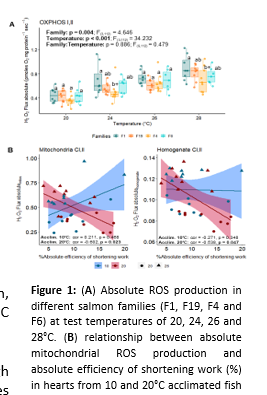ROS PRODUCTION MAY LIMIT THERMAL TOLERANCE AND CARDIAC PERFORMANCE AT HIGH TEMPERATURES IN ATLANTIC SALMON
Given the impacts of climate change, it is important to understand what factors determine thermal tolerance and affect cardiac performance in fishes, and to be able to select for these important indices within populations used in aquaculture. Mitochondrial function [e.g., respiration and reactive oxygen species (ROS) production] is negatively impacted by high temperatures and may limit fish cardiac performance and upper thermal tolerance. Thus, we challenged twenty families of cultured Atlantic salmon to an incremental (+0.2°C day-1) thermal maximum (ITMax) test. ITMax varied significantly between the 20 families (range 25.0 to 23.3°C). Remaining fish from the two most (F19 and F4) and least (F1 and F6) tolerant families (which had been held at 10°C) were then warmed to 18°C, acclimated at this temperature for > 2 weeks, and had their cardiac mitochondrial function assessed at test temperatures of 20, 24, 26 and 28°C (n=7-9). With regard to mitochondrial respiration, there was no clear separation between the temperature tolerant and intolerant families. However, a number of mitochondrial parameters were significantly different between Family 1 and the two tolerant families. For example, values for respiration and in particular absolute ROS production were consistently or often higher for Family 1 at the various test temperatures (Figure 1A). These data suggest that ROS production, not respiratory capacity, limits a fish’s ability to tolerate long-term exposure to high temperatures.
In a second experiment, we acclimated salmon to 10 and 20°C for > 2 weeks and then: used strips from half of the heart’s ventricle to simultaneously measure muscle work and O2 consumption (and thus efficiency) at 20 and 26°C; and used the other half to obtain myocardial homogenates and isolated mitochondria so that mitochondrial function could be measured at the same temperatures. Total CI+CII ROS production was negatively correlated with the efficiency of contraction in 20°C acclimated salmon, whereas this relationship was not evident for 10°C acclimated fish (Figure 1B).
In conclusion, it appears that ROS production at high temperatures contributes to family-based differences in upper temperature tolerance, and may limit myocardial contraction efficiency (and thus heart function) at high temperatures. These latter results are consistent with previous data showing that warm acclimation improves cardiac mitochondrial function at high temperatures.
